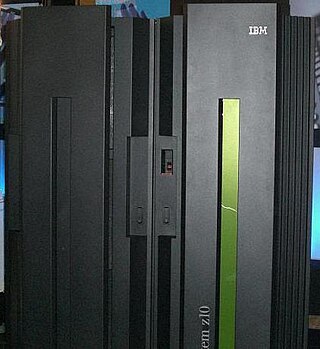IBM mainframes are large computer systems produced by IBM since 1952. During the 1960s and 1970s, IBM dominated the computer market with the 7000 series and the later System/360, followed by the System/370. Current mainframe computers in IBM's line of business computers are developments of the basic design of the System/360.

Multiple Virtual Storage, more commonly called MVS, is the most commonly used operating system on the System/370, System/390 and IBM Z IBM mainframe computers. IBM developed MVS, along with OS/VS1 and SVS, as a successor to OS/360. It is unrelated to IBM's other mainframe operating system lines, e.g., VSE, VM, TPF.

A mainframe computer, informally called a mainframe or big iron, is a computer used primarily by large organizations for critical applications like bulk data processing for tasks such as censuses, industry and consumer statistics, enterprise resource planning, and large-scale transaction processing. A mainframe computer is large but not as large as a supercomputer and has more processing power than some other classes of computers, such as minicomputers, servers, workstations, and personal computers. Most large-scale computer-system architectures were established in the 1960s, but they continue to evolve. Mainframe computers are often used as servers.

VSEn is an operating system for IBM mainframe computers, the latest one in the DOS/360 lineage, which originated in 1965. It is less common than z/OS and is mostly used on smaller machines.

OS/390 is an IBM operating system for the System/390 IBM mainframe computers.

Hercules is a computer emulator allowing software written for IBM mainframe computers and for plug compatible mainframes to run on other types of computer hardware, notably on low-cost personal computers. Development started in 1999 by Roger Bowler, a mainframe systems programmer.

The IBM System/370 (S/370) is a model range of IBM mainframe computers announced on June 30, 1970, as the successors to the System/360 family. The series mostly maintains backward compatibility with the S/360, allowing an easy migration path for customers; this, plus improved performance, were the dominant themes of the product announcement. In September 1990, the System/370 line was replaced with the System/390.

VM is a family of IBM virtual machine operating systems used on IBM mainframes System/370, System/390, zSeries, System z and compatible systems, including the Hercules emulator for personal computers.
The IBM System z Application Assist Processor (zAAP), previously known as the zSeries Application Assist Processor, is a mainframe processor introduced by IBM in 2004. zAAP engines are dedicated to running specific Java and XML workloads under z/OS, accelerating performance. zAAPs are available for zSeries 990 and 890 servers and later zSeries and zEnterprise models. Beginning with the IBM z13, the zAAP functionality is integrated with zIIP processors.
A hypervisor is a type of computer software, firmware or hardware that creates and runs virtual machines. A computer on which a hypervisor runs one or more virtual machines is called a host machine, and each virtual machine is called a guest machine. The hypervisor presents the guest operating systems with a virtual operating platform and manages the execution of the guest operating systems. Unlike an emulator, the guest executes most instructions on the native hardware. Multiple instances of a variety of operating systems may share the virtualized hardware resources: for example, Linux, Windows, and macOS instances can all run on a single physical x86 machine. This contrasts with operating-system–level virtualization, where all instances must share a single kernel, though the guest operating systems can differ in user space, such as different Linux distributions with the same kernel.
z/Architecture, initially and briefly called ESA Modal Extensions (ESAME), is IBM's 64-bit complex instruction set computer (CISC) instruction set architecture, implemented by its mainframe computers. IBM introduced its first z/Architecture-based system, the z900, in late 2000. Later z/Architecture systems include the IBM z800, z990, z890, System z9, System z10, zEnterprise 196, zEnterprise 114, zEC12, zBC12, z13, z14, z15 and z16.
A logical partition (LPAR) is a subset of a computer's hardware resources, virtualized as a separate computer. In effect, a physical machine can be partitioned into multiple logical partitions, each hosting a separate instance of an operating system.

IBM System z9 is a line of IBM mainframe computers. The first models were available on September 16, 2005. The System z9 also marks the end of the previously used eServer zSeries naming convention. It was also the last mainframe computer that NASA ever used.
IBM S/390 Multiprise was a short-lived series of small, compact, entry-level mainframes.
Since the rise of the personal computer in the 1980s, IBM and other vendors have created PC-based IBM-compatible mainframes which are compatible with the larger IBM mainframe computers. For a period of time PC-based mainframe-compatible systems had a lower price and did not require as much electricity or floor space. However, they sacrificed performance and were not as dependable as mainframe-class hardware. These products have been popular with mainframe developers, in education and training settings, for very small companies with non-critical processing, and in certain disaster relief roles.
In IBM System z9 and successor mainframes, the System z Integrated Information Processor (zIIP) is a special purpose processor. It was initially introduced to relieve the general mainframe central processors (CPs) of specific Db2 processing loads, but currently is used to offload other z/OS workloads as described below. The idea originated with previous special purpose processors, the zAAP, which offloads Java processing, and the IFL, which runs Linux and z/VM but not other IBM operating systems such as z/OS, DOS/VSE and TPF. A System z PU is "characterized" as one of these processor types, or as a CP, or SAP. These processors do not contain microcode or hardware features that accelerate their designated workloads. Instead, by relieving the general CP of particular workloads, they often lead to a higher workload throughput at reduced license fees.

IBM Z is a family name used by IBM for all of its z/Architecture mainframe computers. In July 2017, with another generation of products, the official family was changed to IBM Z from IBM z Systems; the IBM Z family now includes the newest model, the IBM z16, as well as the z15, the z14, and the z13, the IBM zEnterprise models, the IBM System z10 models, the IBM System z9 models and IBM eServer zSeries models.
The history of IBM mainframe operating systems is significant within the history of mainframe operating systems, because of IBM's long-standing position as the world's largest hardware supplier of mainframe computers. IBM mainframes run operating systems supplied by IBM and by third parties.

IBM System z10 is a line of IBM mainframes. The z10 Enterprise Class (EC) was announced on February 26, 2008. On October 21, 2008, IBM announced the z10 Business Class (BC), a scaled-down version of the z10 EC. The System z10 represents the first model family powered by the z10 quad core processing engine. Its successors are the zEnterprise System models introduced in 2010 and 2012.
Linux on IBM Z or Linux on zSystems is the collective term for the Linux operating system compiled to run on IBM mainframes, especially IBM Z / IBM zSystems and IBM LinuxONE servers. Similar terms which imply the same meaning are Linux/390, Linux/390x, etc. The three Linux distributions certified for usage on the IBM Z hardware platform are Red Hat Enterprise Linux, SUSE Linux Enterprise Server, and Ubuntu.







